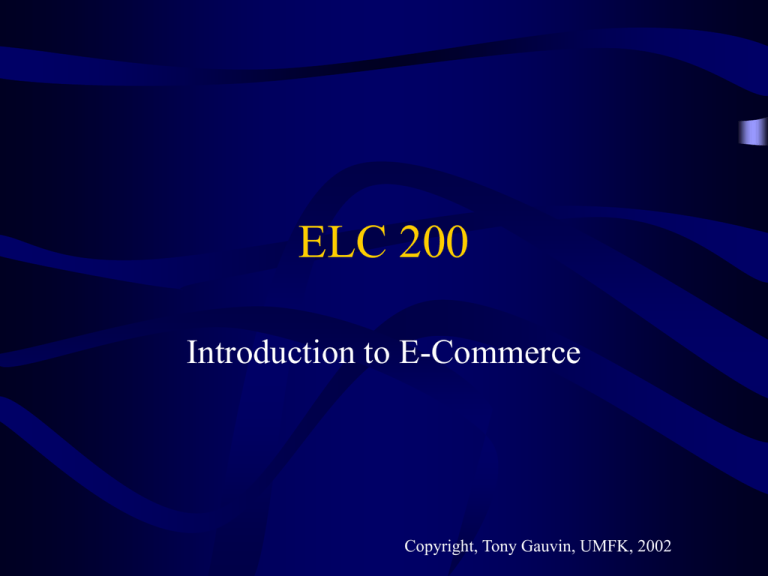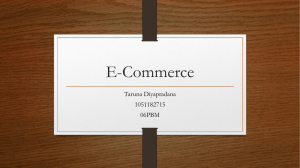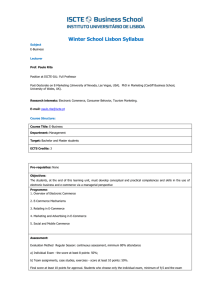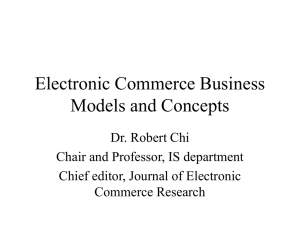
ELC 200
Introduction to E-Commerce
Copyright, Tony Gauvin, UMFK, 2002
Introduction
•
•
•
•
•
•
•
•
Class roll call
Instructor Introduction
Instructor’s Educational Philosophy
Syllabus review
General Information about class
WebCT accounts
Some Group Work
Intro to eCommerce
WWW
Awad –Electronic Commerce 2/e
© 2004 Pearson Prentice Hall
Instructor
• Tony Gauvin
–
–
–
–
–
Assistant Professor Of E-Commerce
216 Nadeau Hall
(207) 834-7519 or Extension 7519
TonyG@maine.edu
WebCT
WWW
Awad –Electronic Commerce 2/e
© 2004 Pearson Prentice Hall
Instructional Philosophy
• Out-Come based education
• Would rather discuss than lecture
– Requires student preparation
• Hate grading assignments
– Especially LATE assignments
• Use class interaction, assignments, quizzes
and projects to determine if outcomes are
met.
WWW
Awad –Electronic Commerce 2/e
© 2004 Pearson Prentice Hall
ELC 200 Survival Primer
• Read Material BEFORE the class discussion
– Summary & Key Terms at EOC
– Review and Discussion Questions in EOC
– Web Exercises
•
•
•
•
•
Check WebCT Often
Use the additional resources identified in syllabus
ASK questions about what you didn’t understand in readings
DON’T do homework at last minute.
REVEIW lectures and notes
• Seek HELP if you are having difficulties
• OFFER feedback and suggestions to the instructor in a constructive
manner
• Student Study Groups are STONGLY Encouraged
WWW
Awad –Electronic Commerce 2/e
© 2004 Pearson Prentice Hall
ELC 200 Specifics
• WebCT used to augment course
• Two Desired outcomes
– The E-Commerce Life Cycle
• Students will understand how a E-Commerce initiative is taken from
vision to Fulfillment
– Entrepreneurship
• Students have the ability to create the framework for a viable ecommerce initiative
• Managerial Perspectives instead of technical
– Technical Portions will be covered in COS XXX classes
– Understanding “Why” instead of “How”
WWW
Awad –Electronic Commerce 2/e
© 2004 Pearson Prentice Hall
Group Work
• Define E-Commerce
– Don’t use the book!
• Identify 3 Technical Drivers of ECommerce
• Identify 3 benefits of E-Commerce
• Identify 3 detractors of E-Commerce
• Identify an E-Commerce Success
• Identify an E-Commerce DUD Awad –Electronic Commerce 2/e
WWW
© 2004 Pearson Prentice Hall
UMFK’s Definition of E-Commerce
• An attempt to achieve transactional efficiency in all aspects
of the design, production, marketing and sales of products
or services for existing and developing marketplaces
through the utilization of current and emerging electronic
technologies
• E-Commerce IS NOT
–
–
–
–
–
E-Business
DOT-COMS (or Dot-Bombs)
E-Marketing
Easy or Cheap
NEW
• There are other definitions..The text book’s author has another less
inclusive definition
WWW
Awad –Electronic Commerce 2/e
© 2004 Pearson Prentice Hall
E-Commerce Degree Program
• Combination of Technical Skills and
Management know-how
• Prepares students for Leadership Roles
– Cadre (team) building
– Broad-based technical underpinnings with one
or two specialist areas
– Understanding of implications of E-Commerce
within an organizational context and within
broader social issues
Awad –Electronic Commerce 2/e
WWW
© 2004 Pearson Prentice Hall
Management Capabilities
•
•
•
•
•
•
•
Financial
Ethical
Marketing
Human Resources
Leadership
Project planning and management
Operations management
WWW
Awad –Electronic Commerce 2/e
© 2004 Pearson Prentice Hall
Technical Skills
• Programming
– Procedural & Scripting
– Object Oriented
– Markup Languages
• System analysis
– Needs assessment
– System design and
Specification
– Project Management
WWW
• Networks
– Design
– Administration
– Security
• Databases
– Design
– Transaction
programming
– Administration
Awad –Electronic Commerce 2/e
© 2004 Pearson Prentice Hall
Chapter 1
In the Beginning
WWW
OBJECTIVES
• What is E-Commerce?
• Advantages and Limitations of
E-Commerce
• Strategy in E-Commerce
• Value Chains in E-Commerce
• E-Commerce Integration
WWW
Awad –Electronic Commerce 2/e
© 2004 Pearson Prentice Hall
What is e-commerce?
•
Electronic Commerce (e-commerce) can be viewed from several perspectives.
– From a communications perspective, e-commerce is the delivery of information,
products and services, and payments through telephone lines, computer networks,
etc.
– From an interface perspective, e-commerce involves various information and
transformation exchanges: B2B, B2C, C2C, B2G, G2C
– From a business process perspective, e-commerce is the applications of technology
toward the automation of business transactions and workflows.
– From a service perspective, e-commerce is a tool that allows firms, consumers and
management the ability to cut service costs, while improving the quality of goods
and increasing the speed of delivery of service.
– As a market, eCommerce is a world-wide network. A local store can open a web
store front and find the world at its doorstep/
– From a online perspective, e-commerce provides the capability of buying and
selling products and information on the Internet.
– From a structural perspective, e-commerce involves various media: data, text, web
pages, Internet telephony, and Internet Desktop video.
WWW
Awad –Electronic Commerce 2/e
© 2004 Pearson Prentice Hall
WHAT IS E-COMMERCE?
•
•
•
•
•
Electronic Presentation of Goods and Services
Automated Customer Account Inquiries
Online Order Taking and Payments
Online Transaction Handling
Automated Supply Chain Management Solutions
WWW
Awad –Electronic Commerce 2/e
© 2004 Pearson Prentice Hall
WHY E-COMMERCE?
•
•
•
•
•
Digital Convergence
Anytime, Anywhere, Anyone
Changes in Organization’s Make-up
Widespread Access to IT
Increasing Pressure on Operating Costs and Profit
Margins
• Demand for Customized Products and Services
• Speed or Time Reduction
WWW
Awad –Electronic Commerce 2/e
© 2004 Pearson Prentice Hall
Agenda
• Questions?
• Finish up on introduction to eCommerce
• Assignment 1
WWW
Awad –Electronic Commerce 2/e
© 2004 Pearson Prentice Hall
E-COMMERCE MYTHS
• Setting up a Web site is easy
• E-commerce is cheap when compared to
purchasing a mainframe
• E-commerce means end of mass marketing
• Everyone is doing it
• E-commerce is lucrative
• E-commerce is revolutionary
• The Internet is a commercial fad that
crashed
Awad –Electronic
Commerce 2/e
WWW
© 2004 Pearson Prentice Hall
E-COMMERCE MYTHS (Cont’d)
• B2C eCommerce is dead
– http://retailindustry.about.com/library/holiday/03/blh_em100803.htm
• Online retailing is always the low-cost channel
• All products can be sold online using identical
business models
• Customers can be bought
• Online firms face less pressure to grow and
achieve economies of scale
• Size is not important for online firms
Awad –Electronic Commerce 2/e
© 2004 Pearson Prentice Hall
• The middleman is out
WWW
Quote from text
• “Ecommerce is everywhere. After boom
and bust, it is not new or unique anymore.
The advantage is that the focus now is on
basic business principles such as return on
investment, building trust, and telling the
customer what is available in stock.
Ecommerce has become just plain
commerce. It is just another channel to
reach customers, vendors and suppliers.”
WWW
Awad –Electronic Commerce 2/e
© 2004 Pearson Prentice Hall
ADVANTAGES OF E-COMMERCE
•
•
•
•
•
•
Lower Transactional Costs
Economical
Higher Margins
Better and Quicker Customer Service
Comparison Shopping
Productivity Gains
WWW
Awad –Electronic Commerce 2/e
© 2004 Pearson Prentice Hall
ADVANTAGES OF E-COMMERCE
(Cont’d)
• Helps People Work Together
• Creates Knowledge Markets
• Promotes Information Sharing,
Convenience and New Customer Control
• Swapping Goods and Services
• Allows High Product Customization
WWW
Awad –Electronic Commerce 2/e
© 2004 Pearson Prentice Hall
LIMITATIONS OF E-COMMERCE
•
•
•
•
•
Security
System and Data Integrity
System Scalability
Not Free-for-All
Consumer Search
WWW
Awad –Electronic Commerce 2/e
© 2004 Pearson Prentice Hall
LIMITATIONS OF E-COMMERCE
(Cont’d)
•
•
•
•
•
•
Fulfillment
Customer Relations
Types of Products
Corporate Vulnerability
Blueprint Development
Risk
WWW
Awad –Electronic Commerce 2/e
© 2004 Pearson Prentice Hall
STRATEGY IN E-COMMERCE
• Critical Success Factors for E-Commerce
– Sound Strategy that has the support of top
management
– Clear Aim (long-term)
– Promotion of Sell Cycle
– Full Technology Utilization
– Scalable and Integrated Business Process
WWW
Awad –Electronic Commerce 2/e
© 2004 Pearson Prentice Hall
SELL CYCLE IN E-COMMERCE
Selling Process Phase What You Want to Do
Attraction
Advertising, Promotions
Conversion
Ease of Use, Effective Presentation
Service and Support
Product Info/Status, Fulfillment
Personalization
Site Customization, Support
Security
Transaction, Authentication
Infrastructure
Scalability, Availability, Hosting
WWW
Awad –Electronic Commerce 2/e
© 2004 Pearson Prentice Hall
Value Chains
• Defined by Michael Porter in his 1985 book
“Competitive Advantage”
• A way for organizing the activities of a business so
that each activity adds value (value-added activity)
or productivity to the total operations of the
business.
• Each activity is said to have a value proposition
• Firms that have identified and optimized their
value chains will have Competitive advantage
over those that have not.
WWW
Awad –Electronic Commerce 2/e
© 2004 Pearson Prentice Hall
VALUE CHAIN IN E-COMMERCE
Support Activities
Corporate
Infrastructure
HR
Management
Technology
Development
Procurement
Inbound Operations Outbound Marketing Service
Logistics
Logistics & Sales
WWW
Primary Activities
Awad –Electronic Commerce 2/e
© 2004 Pearson Prentice Hall
PRIMARY ACTIVITIES
• Inbound Logistics
– Supply line of business
• Operations
– Conversion of raw materials into finished products
– Center of value chain where value-added occurs
• Outbound Logistics
– Storing, distribution and shipping of final product
WWW
Awad –Electronic Commerce 2/e
© 2004 Pearson Prentice Hall
PRIMARY ACTIVITIES (Cont’d)
• Marketing and Sales
– Deals with ultimate customer
• Service
– After-sale service to customer
WWW
Awad –Electronic Commerce 2/e
© 2004 Pearson Prentice Hall
SUPPORT ACTIVITIES
• Corporate Infrastructure
– Backbone of business unit
• Human Resources
– Matching the right people to the right job
• Technology Development
– Product and business processes improvement
• Procurement
– Prerequisite for production
WWW
Awad –Electronic Commerce 2/e
© 2004 Pearson Prentice Hall
E-COMMERCE INTEGRATION
Element
INTERNET EXTRANET
INTRANET
E-Commerce Business-to- Business-toType
Consumer
Business
Business within
Business
Access
Unrestricted Restricted
Restricted
Security
Minimal
Firewalls &
Restricted Access
Firewalls &
Restricted Access
Payment
Method
Credit Card
Predefined Credit
Agreement
Within Business
Charges
WWW
Awad –Electronic Commerce 2/e
© 2004 Pearson Prentice Hall
The Growth in B2B
INDUSTRY
Computing & Electronics
2000
2001
2002
2003
2004
% of
Total
$230.2
$343.3
$427.3
$506.2
$592.9
40%
Motor Vehicles
35.1
90.0
190.2
311.5
411.5
26%
Petrochemicals
27.0
53.9
103.2
184.5
299.2
17%
Utilities
29.9
56.5
101.3
170.1
266.4
17%
Paper & Office Products
14.4
33.7
73.9
143.5
235.3
24%
Consumer Goods
13.2
28.1
58.5
116.5
216.5
13%
Food
22.5
41.2
73.9
128.1
211.1
12%
Construction
6.3
15.1
34.6
74.2
141.0
10%
Pharmaceutical & Med Products
4.3
10.7
26.2
60.2
124.0
14%
Industrial Equipment / Supplies
7.0
13.1
23.8
41.9
70.3
7%
Shipping & Warehousing
4.6
10.5
22.4
42.5
68.1
20%
Aerospace & Defense
9.1
15.8
23.1
29.0
32.9
15%
Heavy Industry
2.6
4.8
8.6
15.3
26.5
3%
406.2
716.6
1,166.9
1,823.4
2,695.5
17%
TOTAL
WWW
Source: Forrester Research, Reported in Blackmon, Douglas, “Where the Money Is,” WSJ, April 17, 2000, p. R30.
Awad –Electronic Commerce 2/e
© 2004 Pearson Prentice Hall
SUPPLY CHAIN MANAGEMENT
•
•
•
•
Reduces Cycle Times
Raise Order Fulfillment
Minimize Excess Inventory
Improve Customer Service
WWW
Awad –Electronic Commerce 2/e
© 2004 Pearson Prentice Hall
INTRANET
•
•
•
•
•
Low Development and Maintenance Costs
Friendly Environment
High Information Availability and Shareability
Timely Information
Easy Dissemination of Information
WWW
Awad –Electronic Commerce 2/e
© 2004 Pearson Prentice Hall
Other eCommerce types
• Business-to-Government B2G
– Procurement GSA office
– OMB contract
– IRS
• Mobile Commerce
– Wireless technologies
WWW
Awad –Electronic Commerce 2/e
© 2004 Pearson Prentice Hall
For next week
• Read Chap Two
– The Internet and the World Wide Web
• Assignment 1
– Answer Test Your Understanding questions on
Page 31 of the text.
– Turn in a well formatted typed response sheet
– Due Tuesday January 10 at start of class
WWW
Awad –Electronic Commerce 2/e
© 2004 Pearson Prentice Hall





